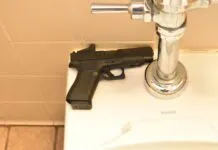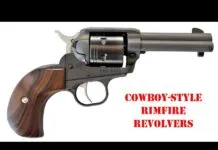Long before WWI the French were hard at work on semiauto rifle designs. Unfortunately they didn’t have much in production at the start of the Great War, so they fought that war largely like the rest of the world did, with bolt-action rifles. It was not until 1949 that France had its own successful semiauto rifle in the MAS, chambered for the 7.5x54mm cartridge, which is similar to the 7.62 NATO round. That rifle was designated the Model 1949, and it incorporated some features of the bolt-action Model 1936, including its cartridge, rear-sight arrangement and two-piece stock. Later modifications developed the M1949 into the Model 1949-56. For this report we acquired one of each type from Collectors Firearms (www.collectorsfirearms.com), the M1949 chambered for the original cartridge and the ‘49-56 rechambered by some arsenal to 7.62 NATO. The French cartridge is a bit longer and very slightly fatter than the NATO cartridge, so we presume the barrel had to be set rearwards to effect the conversion.
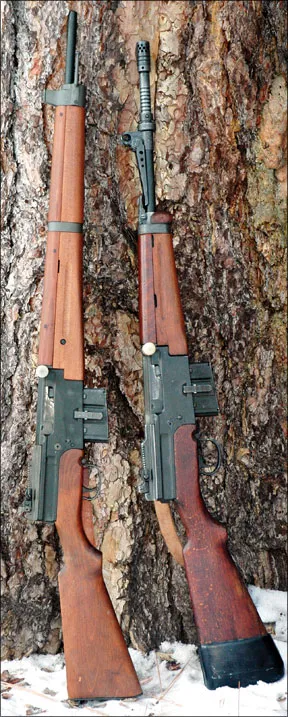
MAS stands for Manufacture Nationale d’Armes de St-Etienne. This is a gas-driven design that would be familiar to the fans of the various AR-15/M-16 rifles. The gas tube impinges directly on the bolt carrier, blowing it rearward with each shot. There are no moving parts, like pistons or pushrods, in the gas system.
Although the rifles had essentially the same actions, the M1949 had only a stacking lug at the front and no muzzle brake, presenting what amounted to a naked barrel muzzle. The ‘49-56 had a grenade launcher, muzzle brake/flash hider, and folding grenade sights. The rear sight on each rifle was an aperture, adjustable upward from 200 to 1200 yards. The front blade on the M49 was a fixed post, but the later rifle had an elevation-adjustable front post.
The detachable magazines had their clasp as part of the magazine, a simple and rugged system that locked into a notch cut in the right side of the action. The 10-round magazines were interchangeable between our two test rifles. Apparently higher-capacity magazines have been available for the MAS rifles. The original parts kits issued with the rifles apparently were well thought out and included critical spare parts, magazines, bayonet, cleaning stuff, and for some, a compact 3.9X scope. All the MAS rifles have a rail on the left side of the action permitting easy scope mounting.
The later rifle had a larger trigger guard, permitting firing with gloves. Both rifles had a simple leather sling attached to the left side of the rifle. The 49-56 had a black slip-on recoil pad, apparently original issue.
Each rifle had a two-piece hardwood stock with a wood hand guard covering the forward part of the barrel and the gas tube. The woods were plain walnut and birch. The safety consisted of a lever located to the right front of the trigger guard. In the safe position it partially obscured the trigger opening, which was more obvious for right handers. Both bolts had a serrated white plastic covering on the bolt knob. The actions were solid, well-made, nicely machined items that looked to be extremely strong. There were no plastic nor flimsy metal parts anywhere on either rifle. These were serious war-time rifles made to work and to last.
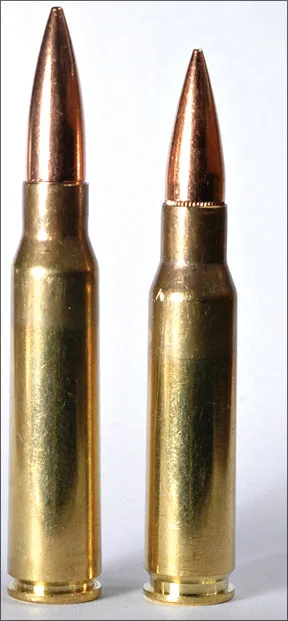
Takedown for these rifles was remarkably simple. After clearing the rifle, remove the magazine and let the slide go forward. Then slide the large button at the rear of the receiver downward, toward the wrist of the rifle. Press forward on the top-rear portion of the action, which is the cover, and when it moves just over half an inch toward the front of the rifle it can be lifted off toward the rear, releasing tension on the recoil spring. Then slide the bolt carrier rearward until the bolt and carrier are all the way back, and they can then be lifted out. That’s it. With a normal cleaning rod the barrel must be cleaned from the front. For reassembly reverse the process. You have to fight the spring a bit, but it’s an easy job. If you have to remove the trigger assembly, you’ll need a screwdriver to remove a slotted screw at the rear of the trigger guard.
Largely because of extremely poor winter weather, we tested the two rifles with one type of ammo each. For the Model 1949 we used Serbian Prvi Partizan 139-grain FMJ, and for the 1949-56 we used Magtech 150-grain FMC. Here’s what we found.
MAS 1949-56 7.62mm NATO/308 Win, $650
The Collectors Firearms tag indicated this rifle was from 1950s production, and had been refurbished and converted at some point to 308. Condition was stated to be very good overall. We agreed with that estimate. The black rubber slip-on pad was marked MAS, 1962. We pulled the rifle apart for cleaning, but left the trigger assembly alone. It was all in fine shape inside, and was all fairly clean when we got the rifle. The bore looked to be at least in very good condition. The Parkerizing was uniform and covered almost everything metal. The firing pin protrusion was on the short side, compared with the 1949. We wondered if it would work properly.
We were fascinated with the grenade-launching sights. To use them a flap first had to be lifted, which cut off the gas port and also obliterated the iron sights. Then a very strong pull rearward on the grenade sight allowed it to be put into slots at either of two elevated positions, at about 45 and 80 degrees. There was a sliding collar behind the muzzle brake and in front of the grenade sight that had to be indexed to the right range, and coordinated with the elevated grenade-launch sight. We were stumped to determine how to use the sights, which seemed to be regulated for precise ranges, but then we read somewhere that the front edge of the grenade itself forms the front sight, and the elevating bar on the rifle forms the rear sight. Mystery solved. We had a drastic shortage of grenades on hand, so we could not test that feature, which is probably just as well.
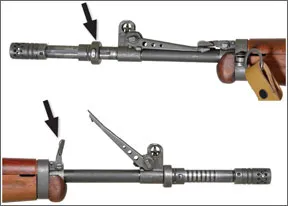
With the rifle assembled and all ready to go, we were eager to shoot the MAS. But with outside temperatures around 5 degrees and massive snow on the range, we didn’t spend a lot of time there. We found the rifle shot relatively well, but also very low. Our first groups were 10 inches below the aim point at 50 yards, so we raised the rear sight to the 600-yard mark. Our hits were still too low. We found the adjustable front sight was fairly high, but it and its locking pin were so gummed up we were unable to lower the sight at all. We figured it needed 2.5 turns to zero the rifle. If we owned this MAS we’d make or borrow a special tool to adjust the front sight, take it all apart, and make it right.
The trigger pull was two stage and fairly excellent, we thought. Ditto the sight picture. The slightly tapered front post was easy to see and well mated with the aperture. The aperture could have been larger, but was okay as it was. We did not have to touch the windage adjustment on the rear sight at all, but did note it moved with solid clicks each half turn. We had several failures to feed during our brief shooting session, which didn’t give confidence in the rifle. The magazine was dry, so we lubricated it but it didn’t solve the problem completely.
The trigger took a little over 6 pounds for the first stage, and about two more for the break. We were able to do good work with the trigger, but the rifle did not reward us. We got about 2.3 inches at 50 yards, or about 4.5 at 100 yards. We had a break in the weather and were able to try the rifle with some surplus 308 and also a few rounds of Winchester match ammo, but not enough of either to get reportable accuracy results. We did have several failures to fire and a failure to eject with the surplus ammo. Our estimate of the too-short firing pin may have been accurate. The primers on the non-firing rounds were barely dented. The commercial Winchester match all fired, as did all the Magtech, which was the official test ammunition. We would replace the firing pin if we owned this rifle, and would be sure to test the setup very thoroughly before we’d call this one ready to go.
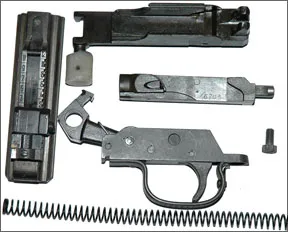
Our Team Said: We liked the feel and look of this rifle but gave it a grade of C because it needed sighting work, had several failures to feed, and most likely needed a new firing pin. We were not entirely happy with the reliability as tested. The accuracy was not up to the other rifle by any means. We found several similar rifles offered at various locations online for significantly less money. However, a good MAS rifle has a lot to offer, we believe. The given price of this one is about half that of a new M1A, and it could give you almost the same capabilities, maybe with a few tweaks. A larger-capacity magazine would be nice, but we couldn’t find any for sale. There was no shortage of the 10-rounders for sale, though. The MAS 1949-56 was clearly designed for durability and easy maintenance, and it had fine handling abilities. The wood stock was friendly even in extreme cold. The good trigger made for easy shooting. Although we liked the fact that it would accept 308 ammo, if we had our choice we’d pick one in the original 7.5 French caliber. Ammo for that is relatively inexpensive and easy to find, and reloading can be done with common bullets, so why not have the gun as it was originally designed. Now, if we can just get some grenades to test those sights….
MAS 1949 7.5x54mm, $850
This rifle had a new stock and essentially perfect Parkerizing. The tag indicated it had been arsenal overhauled and had an excellent bore. We didn’t think the bore was quite excellent, though it was better than the other rifle’s tube. We missed the fun of the grenade sights. Some of the 1949s did have grenade sights, but of a different design. The muzzle had no flash hider, and in fact nothing at all out there but the bare end of the barrel. There was a stacking rod on the front-sight base. The front sight itself was a blocky blade that didn’t appear to be removable. Like on the other rifle the front-sight blade was protected by stout ears, though these were not side-vented like on the ‘49-56.
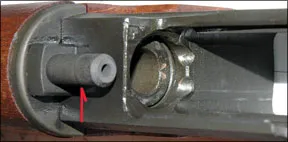
The rear sight was similar to that of the other rifle, ranging from 200 to 1200 meters or yards. The aperture setup was different, with a dovetail arrangement for windage along with fine marks for reference. There was a blade into which the aperture was drilled. This blade was part of a small screw that could be adjusted with a screwdriver at the top of the aperture housing. The screw indexed firmly each half turn, and again there were fine marks for reference. Thus it was possible to raise or lower the hole to get the gun properly sighted. This rifle shot five inches low at 50 yards as we found it, but we were able to get the gun centered easily with this setup, which we liked much more than the later edition. This was a well-made little sight, we thought, that was also quite durable. However, you better have mighty good eyesight to see those fine adjustment marks.
We had no problems with the rifle on the range except for its totally lousy trigger. We were quite sure the safety was on, but with diligence, lots of spinach, and some finger-strengthening exercises we were eventually able to force the trigger rearward far enough to get the gun to fire. It took about 8.5 pounds to overcome the first stage, and it eventually broke at 14 pounds. Despite that bad trigger the rifle shot extremely well, once putting three into half an inch at 50 yards. The French round gave more recoil than we got from the 308 ammo. There were no problems with feed, firing, or ejection.
Our Team Said: We gave it a grade of A-minus, mostly because of the poor trigger. It was nice to see the new stock and pristine Parkerizing, though some might prefer the slightly used look of the other rifle. We were taken with the accuracy of this one, despite its trigger, and also by its reliability. We never had the confidence in the 308 version we had in this one. The trigger was nearly unusable, and fixing it would add to the cost. We took the trigger out and found there was a hairpin spring that powered the hammer, and the tails of that spring also provided the spring tension for the trigger. It ought to be possible to alter the trigger pull fairly easily by someone who knows what he’s doing. The rifle was not fully original, having been arsenal refinished per the tag that came with it, and we noted a variety of unmatched numbers on the parts, so collectors might not be entirely happy with it, even though it was an excellent example of the type.
0311-COLLECTIBLES-ACC-CHRONO.pdf



